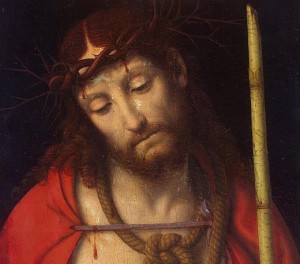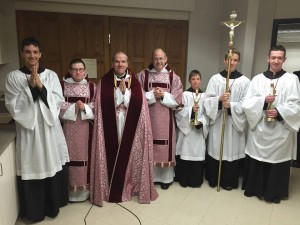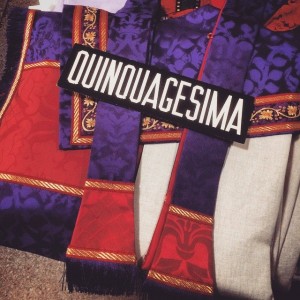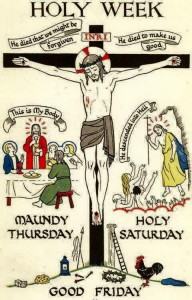Category Archives: Sacred Liturgy
Palm Sunday inspires the works of mercy
 Palm Sunday Reflection from St. Leo the Great:
Palm Sunday Reflection from St. Leo the Great:
“As we prepare to celebrate the greatest of all mysteries, by which the blood of Jesus Christ did away with our sins, let us first of all make ready the sacrificial offerings of works of mercy. In this way we shall give to those who have sinned against us what God in his goodness has already given to us.”
Dealing with liturgical texts
Joseph Shaw published this reflection on the lectionary “How not to deal with offensive liturgical texts” over at the blog, LMS Chairman. You may find the article interesting and helpful.
LÆTARE SUNDAY 2016
 Benedictine monk and priest Father Bede Price preached this sermon today for Lætare Sunday. Father Bede is a member of Saint Louis Abbey and Rector of the Oratory of Ss. Gregory and Augustine (on the campus of St Louis Abbey).
Benedictine monk and priest Father Bede Price preached this sermon today for Lætare Sunday. Father Bede is a member of Saint Louis Abbey and Rector of the Oratory of Ss. Gregory and Augustine (on the campus of St Louis Abbey).
LÆTARE SUNDAY 2016
The study of how traditions developed surrounding the sacred Liturgy and especially the Church Year is fascinating. Almost all the Sundays of the year have an “Official” designation taken from the first few words of the Introit of the Mass. But many of them, likewise have unofficial nicknames or folk designations based on traditions that surround them. Thus we have “Stir-up Sunday” at the start of Advent, where the collect of the Mass, Excita quæsumus, Domine, reminds housewives they need to get going with their Christmas puddings, or “Plough Sunday” after Epiphany when the holiday time of the Twelve Days of Christmas was over and the agricultural work year had to begin again; and so on. The term “Lent” itself is just a nickname, being an Old English word that simply means “Spring” (The Official name of Lent is Quadragesima, which just means “The 40 Days”.
Thus this Sunday in Lent is traditionally and officially known as “Laetare” Sunday from the opening words of the Mass Lætare Jerusalem — “Rejoice, O Jerusalem”. Its festivities mark the halfway point during the season of Lent and so in many places its called “Mid-Lent Sunday.” Strictly speaking, the Thursday before Lætare Sunday is the middle day of Lent, and at one time it was observed as such. Later, the special signs of joy permitted on this day, intended to encourage the faithful in their course through the season of penance, were transferred to the Sunday following. These consist (like those of Gaudete Sunday in Advent, which came much later and really just imitate Lætare) of the use of flowers on the altar, of the use of the organ at High Mass and Vespers; and perhaps most famously (or infamously), rose-coloured vestments are allowed instead of the usual penitential purple. The stational Church in Rome today is the church of S. Croce in Gerusalemme, one of the seven chief basilicas and in this context the Introit’s call for Jerusalem to rejoice is all the more obvious.
S. Croce is the basilica built in the fourth century by the Emperor Constantine. The Emperor’s holy mother, St Helena, enriched it with the most precious relics of the Passion, and wished to make it the Jerusalem of Rome. She even had shiploads of earth from Mount Calvary brought to Rome to be put down on the site of the basilica. Here pilgrims could venerate the relics of the Passion especially the inscription which Pontius Pilate ordered to be fastened to the Lord’s Cross. The name of Jerusalem, which has been given to this Basilica, calls to mind the heavenly Jerusalem, the Church, which is the subject of the Epistle for this Mass: “The Jerusalem above is free, and she is our mother.” Up to the 14th century, when Avignon became for a time the city of the Popes, the ceremony of the Golden Rose took place in this Church.
The Blessing of the Golden Rose is one of the ceremonies peculiar to the Papal Liturgy for the Fourth Sunday of Lent, which gives this Sunday another one of its nick names: Rose Sunday. We find it observed under the pontificate of St Leo IX (11th century); and we have a sermon on the golden rose preached by the Pope Innocent III (1198-1216)—on this Sunday. In the middle ages, when the Pope resided in the Lateran palace, having first blessed the rose, he rode on a donkey to S. Croce accompanied by all the Cardinals, the clergy and the faithful, where he again blessed the golden rose which remained on the altar through the Mass and was later sent it as a special gift to whomever he wished to honor.
The English-speaking world has given many other quaint names to this Sunday: it is sometimes called “Refreshment Sunday”, or the “Sunday of the Five Loaves” (from the miracle recorded in the Gospel); in England it is called “Mothering Sunday”, an allusion to the Epistle, but also because formerly the faithful used to pay their tithes in the cathedral or mother-church of the diocese on this day. Servant girls (like poor Hagar) were given the day off to go to visit their families and took little fruit cakes called Simnel Cakes to their mothers. Not surprisingly in some places today is called “Simnel Sunday”. Over time this custom translated into the secular holiday that we celebrate in May as “Mothers’ Day”.
In the end, Shakespeare got it right, “A rose by any other name would smell as sweet.” Whatever name we give it, the connection between this Sunday and the approaching season of Passiontide is worth noting. As Christians, we know the rest of the story, and therefore as we now turn our attention to the contemplation of the suffering and agony of Our Lord, we can truly rejoice in the mystery of the Cross, which of course St Paul tells us is our boast and in which we glory and through which we are saved and delivered. Therefore on this Sunday, as we now prepare to redouble our efforts at penitence, we cast Lent aside in our joy at the approaching Feast of Easter at least for one day. Moreover, we are not just permitted to enjoy those little things we gave up at Ash Wednesday, we are actually ordered to do so: Lætare Jerusalem, gaudete cum lætitia, exultetis et satiemini.
Quinquagesima Sunday -the Vocation of Abraham
 Be thou unto me a God, a protector, and a place of refuge, to save me: for thou art my strength and my refuge: and for thy name’s sake thou wilt be my leader, and wilt nourish me. In thee , O Lord, I have hoped, let me never be confounded: deliver me in thy justice, and set me free.
Be thou unto me a God, a protector, and a place of refuge, to save me: for thou art my strength and my refuge: and for thy name’s sake thou wilt be my leader, and wilt nourish me. In thee , O Lord, I have hoped, let me never be confounded: deliver me in thy justice, and set me free.
Introit for the Mass, Quinquagesima Sunday
The pre-lenten preparations continue today with the drawing of our attention to the penitential nature of Lent. As Abbot Granger called today, it is the day on which we recall the vocation of Abraham: “preserved those sacred truths” revealed to us by the Divine Majesty. The Church reminds us that Abraham is the model of what complete trust and belief in God ought to look like: from adoring idols to belief in a personal, loving and just God. We know that God chooses us, just as he chose Abraham.
Abbot Ælfric of Eynsham (c. 955 – c. 1010) gives us an insight into this liturgical season when he encourages his monks, saying: “Now a pure and holy time draws near, in which we should atone for our neglect. Every Christian, therefore, should come to his confession and confess his hidden sins, and amend according to the guidance of his teacher.”
So, the key here is to resolve with God’s grace to make time to pray , go to confess sins, fast, and give alms.
As a point of comparison, the Eastern Churches mark this Sunday by abstaining from dairy; this minor penitential day is called Cheesefare Sunday (a “good bye” to dairy products until Easter).

